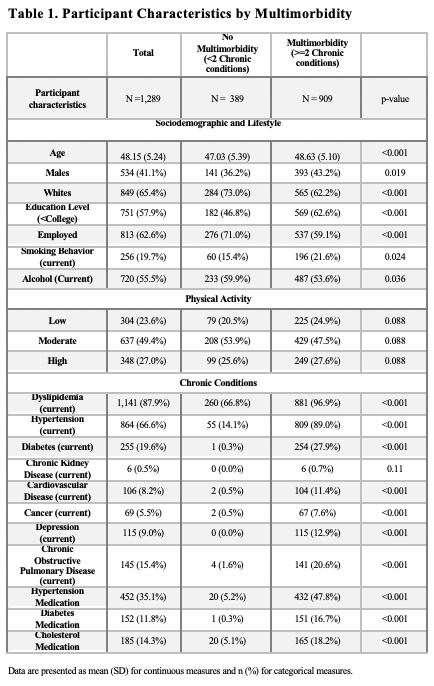Final ID: P2132
Impact of Midlife Physical Activity on Multimorbidity in a Rural Setting: Insights from the Bogalusa Heart Study
Abstract Body: Introduction: The prevalence of multiple chronic conditions (CCs), especially cardiovascular-related, is increasing, leading to higher disability and mortality. Midlife is a critical period for the development of CCs, necessitating interventions to prevent progression to multimorbidity. Physical activity (PA) is a key intervention to reduce the risk of developing multimorbidity. However, the impact of midlife PA on CCs in rural communities remains under-explored. This study examined the relationship between PA and multimorbidity (defined as >2 CCs) in a rural middle-aged population.
Hypothesis: Participants in midlife with higher levels of PA would be less likely to present multimorbidity compared to those with low PA.
Methods. We examined 1,289 participants (mean age 48 ± 5.24 years; 34.6% Black, 65.4% White) from the Bogalusa Heart Study, a long-term longitudinal rural study. Logistic regression models assessed the association between PA scores low (minimal or no PA), moderate (>=600 MET-Minutes/week), and high (>=3,000 MET-Minutes/week) using the International Physical Activity Questionnaire (IPAQ) long form and multimorbidity defined as >2 CCs. Eight CCs (hypertension, dyslipidemia, diabetes, chronic kidney disease, cardiovascular disease, cancer, depression, and chronic obstructive pulmonary disease) were selected based on Centers for Medicare & Medicaid Services guidance using self-reported medical history. Models were adjusted for age, race, and sex.
Results: Moderate PA was associated with lower odds of multimorbidity compared to low PA (Unadjusted OR=0.724, 95% CI=0.534–0.983, p=0.038), though this was not statistically significant after adjustment (OR=0.782, 95% CI= 0.57–1.06, p=0.114). Individuals with high PA scores also showed lower odds of multimorbidity in the unadjusted model (OR=0.88, 95% CI=0.62–1.24, p=0.482) but was not statistically significant after adjustment (OR=0.91, 95% CI=0.64-1.30, p=0.627).
Conclusion: The data suggest a possible link between PA and multimorbidity, though no direct association was established. The reduced odds of multimorbidity with higher PA diminished after adjusting for sociodemographic factors, highlighting the need to consider these influences when evaluating PA's benefits in rural settings. Future studies should aim to better understand sociodemographic factors to develop effective and tailored PA interventions that can promote health and reduce CCs in rural populations.
Hypothesis: Participants in midlife with higher levels of PA would be less likely to present multimorbidity compared to those with low PA.
Methods. We examined 1,289 participants (mean age 48 ± 5.24 years; 34.6% Black, 65.4% White) from the Bogalusa Heart Study, a long-term longitudinal rural study. Logistic regression models assessed the association between PA scores low (minimal or no PA), moderate (>=600 MET-Minutes/week), and high (>=3,000 MET-Minutes/week) using the International Physical Activity Questionnaire (IPAQ) long form and multimorbidity defined as >2 CCs. Eight CCs (hypertension, dyslipidemia, diabetes, chronic kidney disease, cardiovascular disease, cancer, depression, and chronic obstructive pulmonary disease) were selected based on Centers for Medicare & Medicaid Services guidance using self-reported medical history. Models were adjusted for age, race, and sex.
Results: Moderate PA was associated with lower odds of multimorbidity compared to low PA (Unadjusted OR=0.724, 95% CI=0.534–0.983, p=0.038), though this was not statistically significant after adjustment (OR=0.782, 95% CI= 0.57–1.06, p=0.114). Individuals with high PA scores also showed lower odds of multimorbidity in the unadjusted model (OR=0.88, 95% CI=0.62–1.24, p=0.482) but was not statistically significant after adjustment (OR=0.91, 95% CI=0.64-1.30, p=0.627).
Conclusion: The data suggest a possible link between PA and multimorbidity, though no direct association was established. The reduced odds of multimorbidity with higher PA diminished after adjusting for sociodemographic factors, highlighting the need to consider these influences when evaluating PA's benefits in rural settings. Future studies should aim to better understand sociodemographic factors to develop effective and tailored PA interventions that can promote health and reduce CCs in rural populations.
More abstracts on this topic:
A platelet biosignature in psoriasis associates with enhanced cardiovascular risk
Drenkova Kamelia, Lo Sicco Kristen, Berger Jeffrey, Garshick Michael, Kazatsker Filipp, Muller Matthew, Schlamp Florencia, Luttrell-williams Elliot, Liberow Sarah, Mcgirl Siobhan, Kennedy Lauren, Garelik Jessica
A machine learning approach to examining the associations of minority stressors and physical activity among sexual and gender minority adultsLopez Veneros David, Ensari Ipek, Bhilegaonkar Riya, Sharma Yashika, Caceres Billy


